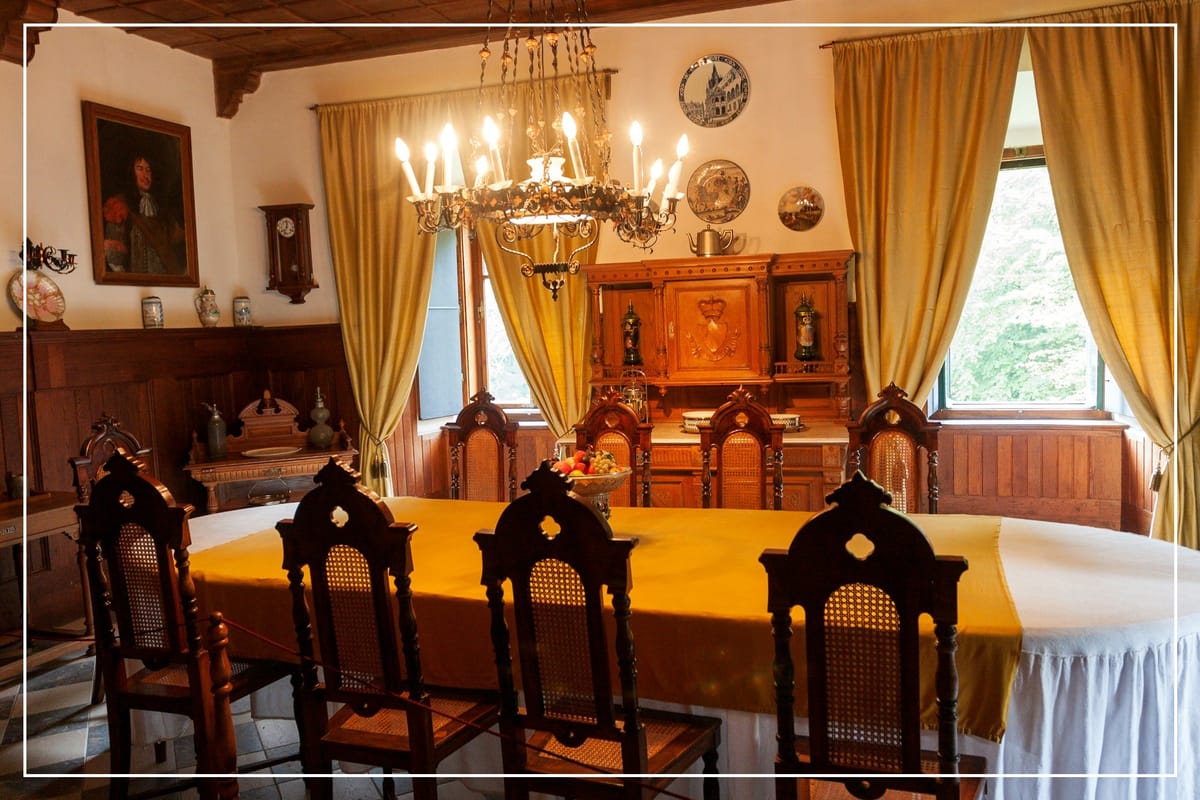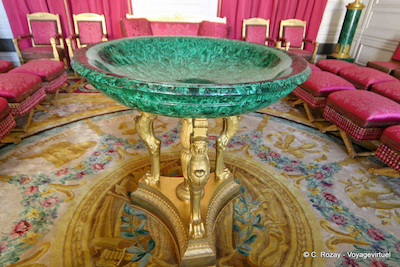Catherine the Great’s Furniture: A Blend of Grandeur and Elegance
Explore the luxurious and opulent furniture styles favored by Catherine the Great in her regal palaces.

Catherine the Great, Empress of Russia from 1762 to 1796, was known not only for her powerful reign and enlightened policies but also for her profound influence on art, culture, and interior design. Her reign is often referred to as the golden age of Russian architecture and arts, and one area where her influence is particularly notable is in the realm of furniture.
Catherine the Great's taste for luxury, elegance, and refinement led to the creation of some of the most exquisite pieces of furniture in European history. These pieces were not only functional but also works of art, designed to reflect the grandeur of her court and the cultural renaissance she championed in Russia. This article explores the history, style, craftsmanship, and legacy of Catherine the Great’s furniture—a symbol of opulence and sophistication.
Table of Contents
- Introduction
- The Influence of Catherine the Great on Interior Design
- The Style and Characteristics of Catherine the Great’s Furniture
- The Craftsmanship Behind Catherine the Great's Furniture
- Key Pieces from Catherine the Great’s Collection
- The Legacy of Catherine the Great’s Furniture
- Conclusion: The Enduring Appeal of Catherine the Great's Furniture
- Further Exploration: Learn More About Art and Design
The Influence of Catherine the Great on Interior Design

Catherine the Great was a passionate patron of the arts, and her influence extended far beyond the borders of Russia. She admired and drew inspiration from the European Enlightenment, particularly the works of French and German artisans. Under her reign, Russia experienced a cultural revolution, and one of her greatest contributions was the transformation of Russian interiors to reflect a blend of Western European styles with Russian grandeur.
The Enlightenment and French Influence
Catherine was heavily influenced by the French Enlightenment, and her personal taste leaned towards the neoclassical style that was sweeping through Europe during her reign. She was an avid collector of art and furniture from France, importing pieces and even commissioning French artisans to create custom furniture for her palaces.
French neoclassicism, which drew inspiration from the ancient Greek and Roman eras, was marked by clean lines, symmetry, and a sense of proportion. These elements found their way into Catherine the Great’s furniture collections. She also embraced the Rococo style, with its more ornate and decorative elements, often characterized by intricate carvings, gilding, and elaborate upholstery.
Russian Interpretation of European Styles
While Catherine adopted European design principles, she also encouraged the development of a distinctly Russian interpretation of these styles. Her love for opulence meant that Russian craftsmen took neoclassicism and Rococo and made them grander, more detailed, and often more luxurious than their Western counterparts.
Russian artisans began to blend traditional Russian elements with European influences, creating furniture that was unique to Catherine’s court. Lavish ornamentation, intricate marquetry (the use of inlaid wood to create decorative patterns), and rich materials such as gold leaf, marble, and fine woods became hallmarks of Catherine’s furniture.
The Style and Characteristics of Catherine the Great’s Furniture

The furniture during Catherine the Great’s reign is noted for its neoclassical elegance and Rococo opulence, embodying the characteristics of the artistic movements she favored. Below are some of the defining features of furniture associated with Catherine the Great:
Neoclassical Symmetry and Proportion
One of the key characteristics of Catherine’s furniture is its neoclassical symmetry. Inspired by the ancient Greeks and Romans, neoclassical design emphasized harmony, proportion, and simplicity. The furniture was often balanced and symmetrical, with clean, straight lines that gave the pieces a sense of order and refinement.
Example: Catherine’s dining tables and chairs often featured perfectly balanced geometric shapes, with straight legs and rectangular or oval tops, adorned with classical motifs such as laurel wreaths, acanthus leaves, and Greek key patterns.
Rococo Ornamentation
In contrast to the restraint of neoclassicism, Catherine also embraced the exuberance of the Rococo style, particularly for more decorative pieces. Rococo was known for its intricate ornamentation, flowing lines, and playful motifs. Gilded accents, curved shapes, and elaborate carvings were common features.
Example: Chairs and settees were often upholstered in luxurious fabrics like silk and brocade, with ornate gold detailing on the arms and legs. The backs of chairs might feature elaborate scrollwork or floral carvings.
Luxurious Materials

Catherine’s furniture was made from the finest materials available. The use of exotic woods such as mahogany, rosewood, and ebony was common, as was the use of gilded bronze, marble, and mother-of-pearl inlay. Velvet, silk, and brocade fabrics were used to upholster chairs, sofas, and chaise lounges, adding to the sense of luxury.
The Craftsmanship Behind Catherine the Great's Furniture
The furniture commissioned by Catherine the Great was not only beautiful in design but also represented the pinnacle of craftsmanship. She employed some of the most talented artisans and craftsmen of her time, including both foreign and Russian artists. Many pieces were created by master furniture makers from France and Germany, while local Russian workshops also thrived under her patronage.
French and German Influence
French and German artisans were at the forefront of neoclassical furniture design during Catherine’s reign. Some of the most notable furniture makers who contributed to Catherine’s collection include David Roentgen, a celebrated German cabinetmaker, and Jean-Henri Riesener, a French ébéniste (cabinetmaker) who was known for his elaborate, highly decorative work. Roentgen’s mechanical furniture—pieces that featured hidden compartments and intricate mechanisms—was particularly prized by Catherine for its ingenuity and craftsmanship.
Russian Craftsmanship
While Catherine imported many pieces from France and Germany, she also played a significant role in nurturing Russian craftsmanship. Russian artisans learned from their European counterparts but quickly developed their own distinctive style. The Kremlin Armory and other workshops in Moscow and St. Petersburg became centers of excellence in furniture making, producing some of the finest marquetry, gilding, and inlay work in Europe.
Example: A famous piece attributed to Russian craftsmanship is the Amber Room, a dazzling chamber in Catherine's Winter Palace, lined with panels of amber, gold leaf, and mirrors. Although technically not furniture, the room’s intricate design exemplifies the luxurious aesthetic Catherine favored.
Further Reading:

Key Pieces from Catherine the Great’s Collection
Some of the most iconic pieces of furniture associated with Catherine the Great’s reign are still admired today. A few examples include:
The Catherine the Great Desk
This extravagant desk was designed by David Roentgen and was notable for its complex mechanical design. It featured hidden drawers and compartments that could be opened with secret mechanisms. The desk was also adorned with marquetry depicting classical themes and gilded bronze mounts, reflecting the neoclassical style.
The Imperial Thrones
Catherine commissioned several thrones during her reign, each more extravagant than the last. One of the most famous is the Imperial Throne of Russia, crafted from gold and adorned with precious gems and intricate carvings. It is a symbol of her absolute power and grandeur and remains a masterpiece of craftsmanship.
The Malachite Room Furniture

In the 1780s, Catherine commissioned furniture for the Malachite Room in the Winter Palace, which was later completed by her successors. The room featured tables, chairs, and cabinets inlaid with green malachite, a rare and precious stone, giving the furniture a rich, luxurious appearance. The vibrant green color of the malachite was contrasted with gilded accents, creating a striking visual effect.
The Legacy of Catherine the Great’s Furniture
Catherine the Great’s influence on furniture design extended far beyond her lifetime. The pieces created during her reign set a standard for opulence and craftsmanship, inspiring future generations of designers and craftsmen. Her patronage of the arts and her love for European styles helped shape the future of Russian interior design, blending Western influences with Russian aesthetics.
Her legacy continues to live on in museums, palaces, and private collections worldwide. The Hermitage Museum in St. Petersburg, which Catherine founded, houses many pieces from her collection, providing visitors with a glimpse into the world of 18th-century Russian luxury. The furniture from her era is still studied and admired for its artistic and historical value.
Conclusion: The Enduring Appeal of Catherine the Great's Furniture
Catherine the Great’s furniture is a testament to her taste for luxury, sophistication, and artistic innovation. The pieces she commissioned during her reign remain some of the most celebrated examples of 18th-century European and Russian craftsmanship. From neoclassical desks to Rococo settees, her furniture reflected the cultural renaissance she fostered in Russia, blending Western design with a distinct Russian flair.
Today, Catherine the Great’s furniture continues to inspire interior designers, historians, and collectors, representing an era of elegance and opulence that defined the Russian Empire. Her legacy as a patron of the arts lives on, making her one of the most influential figures in the history of design and culture.
Further Exploration: Learn More About Art and Design
If you're interested in diving deeper into the history of design, craftsmanship, and artistic influence, tales.so offers summaries of key books on art history and design. Whether you're fascinated by the elegance of neoclassical furniture or the artistry of Rococo decor, book summaries can provide you with deeper insights into the world of Catherine the Great and beyond.
Explore our curated collection of books on art, design, and history at tales.so and uncover the rich stories behind some of the world’s most famous artistic movements!




